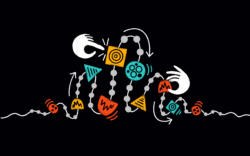One of the incredible things about music is the infinite possibilities that you have when it comes to aspects like rhythms and patterns.
That said, there are some particularly influential rhythms that have shaped a wide array of genres and styles across the globe. Below, we summarize the origins and musical qualities of five of these rhythms—make sure you also check out our tutorial above to learn more and hear them in action.
1. Tresillo
The tresillo is the most fundamental rhythmic pattern in Sub-Saharan African music as well as Latin American music. The term translates to “triplet”—that said, it’s important to note that even though there are three notes in the rhythm, it’s a duple-based pattern (meaning we divide the beat with even numbers). In common time, the tresillo could look like two dotted quarter notes followed by a quarter note.
Go to 0:11 in the video to learn more about the tresillo and hear it in action.
2. Hemiola
An extremely common application of polyrhythms, the hemiola creates a two-against-three feel (i.e. one rhythm is playing three evenly-spaced notes in the same duration of time that another rhythm is playing two). Hemiolas are widely used in drum patterns as well as melodies.
Go to 1:41 in the video to learn more about hemiolas and hear them in action.
3. 12/8 bell
Also simply known as “the bell pattern” in Central and Western African music, the 12/8 bell is a unique pattern that can easily be heard in both 4 and in 3. An audio illusion of sorts, this pattern can really open up a listener’s ears to the idea of rhythmic perception.
Go to 2:57 in the video to learn more about the 12/8 bell and hear it in action.
4. Clave
The clave is one of the staple rhythms of many Afro-Cuban genres as well as Sub-Saharan African music. It’s a four-beat pattern that builds on the structure of the tresillo, and slight variations create the son clave, rumba clave, 2-3 son clave, and 2-3 rumba clave. Influences of this rhythm can be found across an incredibly wide range of genres, even including the likes of EDM and hip hop.
Go to 4:00 in the video to learn more about the clave and hear it (and its variations) in action.
5. Tha dhi gi na thom
Last but not least, tha dhi gi na thom is an element of the South Indian tradition known as Solkattu. Constituted by five-note groupings, this rhythm can really help musicians develop their understanding of subdivision and tuplets.
Go to 5:18 in the video to learn more about tha dhi gi na thom and hear it in action.
Which rhythm did you find most interesting? Are there any important rhythms that we missed? What topics would you like to see us explore on the Splice YouTube channel next? Let us know in the comments section of the video.
From September to October, we’re celebrating Lineage, exploring historical, familial, cultural, and musical histories alongside the creators, artists, and sound designers who have made Latin music the powerhouse it is today:
October 3, 2023

.svg)
.svg)



